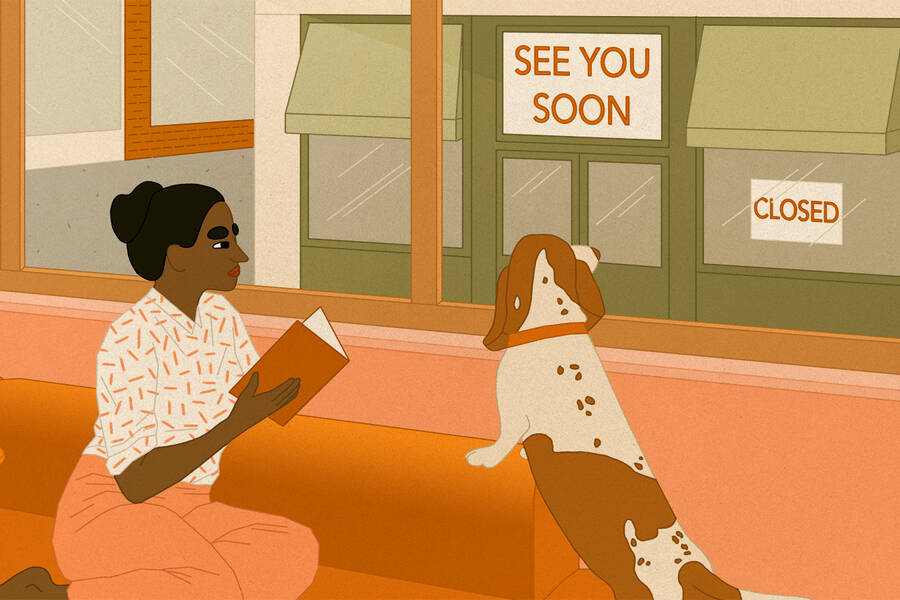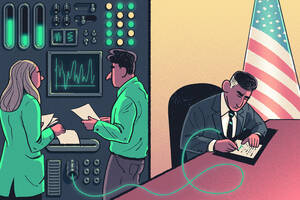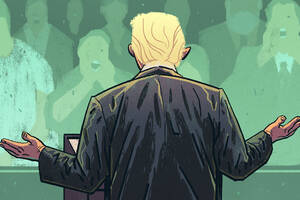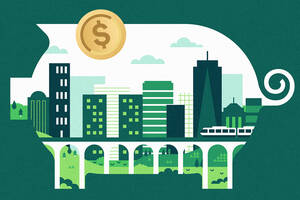Policy May 7, 2020
What Can the Federal Government Do to Get the Economy Back on Track?
A former White House economist weighs the pros and cons of job-retraining programs, aid for states, and universal basic income.
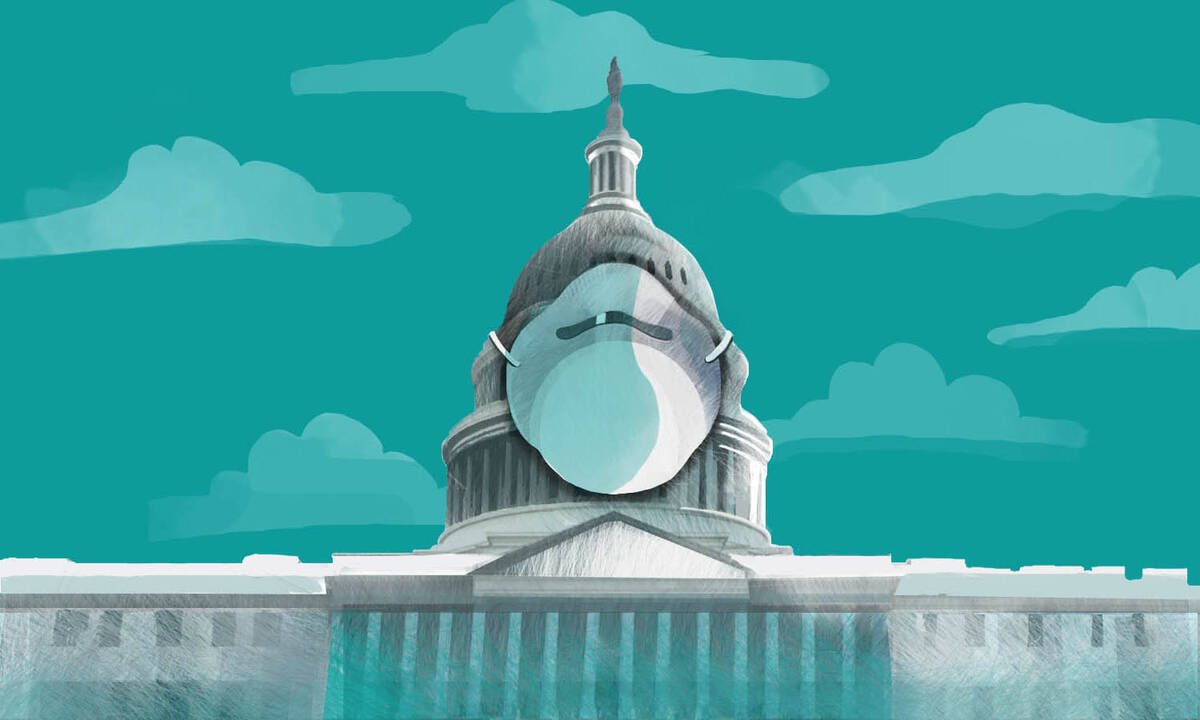
Yevgenia Nayberg
What federal actions will be necessary to pull the U.S. out of a recession?
It’s a question Ben Harris has thought about a lot. Harris served as the chief economist and economic advisor to Vice President Joe Biden starting in 2014 and initially served in the Obama White House in 2011 as the U.S. was pulling itself out of its last recession. He is now a visiting associate professor at Kellogg and the executive director of the Kellogg Public–Private Initiative.
Kellogg Insight recently spoke with Harris about the steps that already have been taken in Washington to respond to the COVID-19 economic crisis, the policies he hopes could put millions back to work, and why this pandemic is forcing us as individuals to make hard choices about how to spend our money.
This has been edited for length and clarity.
Kellogg Insight: What has happened at the federal level to deal with the economic fallout from COVID-19, and what still needs to happen?
Ben Harris: Four stimulus bills have been passed to deal with this crisis, which some refer to as Stimulus 1, 2, 3, and 3.5, because the final one mostly just gave more money to programs created by the third stimulus bill, namely the Paycheck Protection Program. Combined these total about $3 trillion.
Through these bills, in general, we’ve done a good job of allocating enough dollars for households, unemployed people, and businesses to weather the first few months of the downturn. We’ve done an insufficient job of actually implementing these programs, however. For a wide array of reasons, the dollars haven’t flowed to the entities that we wanted them to: workers are still struggling to sign up for unemployment insurance, millions of people haven’t yet received a stimulus check, and small businesses haven’t all been able to receive PPP funds.
The two big things we need to do now—in the next six weeks, if not sooner—are to start implementing these programs better and to do a sufficient job of supporting states and cities, which we haven’t done yet.
But then there’s the bigger question of how to address the massive dislocation in the labor market. We have roughly 33 million people (and counting) who have applied for unemployment-insurance benefits. When businesses reopen, some people will go back to their jobs, but many jobs will have disappeared: we’ll have this unprecedented workforce dislocation that we’re going to have to deal with. This will require retraining and redirecting workers.
Insight: One policy idea that has come up is simply to provide everyone with a Universal Basic Income throughout the length of the pandemic. What do you think about something like that?
Harris: I was not a fan of UBI before this crisis, and I’m even less of a fan of UBI now. We have a situation where there are some workers, and some businesses, that are really struggling. But then there are others who are basically just working in a different place, right? So UBI says, “Let’s just go ahead and give everyone, regardless of who you are, some amount of money”—Andrew Yang proposed $1,000 a month. The problem is that this approach is inefficient. Some people don’t need that money, and some people need more than that. The UBI approach, where one size fits all, doesn’t feel appropriate for the moment, where needs are so dispersed.
Insight: So you would favor putting some of that money toward retraining and redirecting workers. What do you mean by that?
Harris: There are a few different buckets of things to do. The first bucket includes directing workers to jobs that we’ve known for a long time are in demand: programmers, for instance, or home healthcare workers for people with disabilities and older Americans. It feels like the perfect opportunity to start training more people for those jobs.
The second bucket includes what I might call “readiness jobs”—jobs that help us, in the very near term, get back on track. We need contact tracers, and we need workers to administer vaccines. We also need more people to help administer unemployment-insurance benefits and work on cybersecurity. We’re going to need a lot of childcare workers, particularly if schools don’t reopen en masse in the fall.
“I worry that we’re going to repeat the same mistakes we made in 2010.”
— Ben Harris
The third bucket is more forward-looking: It’s impossible to think of a circumstance in which our country is better positioned to massively invest in infrastructure and clean energy. Long-term interest rates are close to zero, which means we can basically borrow to pay for productive investment at a very low cost.
Insight: You mentioned that states and municipalities have been largely left out of the previous bills. States are responsible for delivering a lot of the social safety net at a time when their revenue streams have cratered. How do you see this playing out?
Harris: In the Great Recession, most of the aid to states came through the Recovery Act, which was passed in February 2009. And that was roughly an $800 billion bill, of which about $160 billion went to states.
What happened in the Great Recession though, is that after that amount, which was sufficient for states to get through 2010, Congress didn’t allocate any other money. And states really aren’t set up to borrow, as they are generally prohibited from running deficits. As a result, states were a big drag on the recovery, cutting services and jobs. A lot of states didn’t get back to their pre-recession levels of spending until 2018 or 2019, and some states have still not gotten back there when it comes to things like higher education or K-12 funding.
This time around, the CARES Act, which is the $2.2 trillion signature relief package, did send $142 billion to cities and states, distributed by population. But my guess is that states will end up needing around half a trillion dollars for the next two years, so $142 billion is wholly insufficient. A lot of states and some cities are already starting to cut workers and cut services. It’s incredibly problematic, and unless Congress comes through with a big, effective package, I worry that we’re going to repeat the same mistakes we made in 2010.
Insight: You’ve talked a lot about the policies coming through Congress. But the Federal Reserve has also been very busy responding to this crisis. Can you describe what is happening at the Fed?
Harris: It would almost be easier to talk about what the Fed is not doing, because they’re doing so much. To the Fed’s credit, they acted early, and they acted big. They started cutting rates far before Congress passed its bills. And since then, they’ve done about 15 or 20 different things, so it’s tough to characterize them all.
But again, we can think of them in terms of buckets. The Fed has a traditional way of acting, which is basically just cutting rates in a recession. On March 3, it went ahead and brought down the interest rate it charges banks to zero. It also offered what’s called “forward guidance”—giving investors and members of the business community reassurance that rates are low and they’re going to stay low until the economy is back on track. These traditional activities make up the first bucket.
The second bucket includes quantitative easing, which the Fed first did during the Great Recession. It started buying up a lot of Treasury securities and mortgage-backed securities—bundles of mortgages packaged together. In 2008, we had a situation where investors didn’t want to buy mortgages because they were worried about not getting paid—so much so that these securities were labeled “toxic.” And markets need both sellers and buyers to function. Imagine a farmer’s market where everyone is selling eggs and flowers, but there are no buyers: you’re not going to have transactions, and eventually farmers are going to start selling at fire-sale prices.
Today, the situation is even more severe, so the Fed is stepping in to be the buyer for a lot of these markets—but the type of debt it’s buying goes well beyond the Treasuries and bundled mortgages they were picking up a decade ago. And they’re basically printing money to do this. Now, in normal circumstances you might start worrying about inflation, but when you’re in the heart of a depression, or a really steep recession, inflation really isn’t a problem. You are more concerned about deflation, because everyone’s spending so much less.
Insight: Wait a minute. If they can do that, why can’t the Fed just print money for the infrastructure or green energy projects you mentioned earlier? Can they be even more aggressive than they are already being?
Harris: In general, the Fed really doesn’t take on those types of projects. They are not the Treasury; they have different goals, and there are laws limiting how the Fed can interact with the non-bank economy. That said, here’s how I look at it: if the federal government goes ahead and issues bonds for these projects, and the Fed is buying up bonds, in practice you have a situation where the Treasury is issuing bonds that the Fed pays for.
Insight: Wow!
Harris: The third bucket of things that the Fed is doing right now is encouraging banks to lend. Basically, it has relaxed some regulatory requirements, including how much capital banks have to keep on hand.
And the fourth bucket—which is novel to this crisis—is opening up direct lending to larger businesses. This was done largely in conjunction with the Treasury Department, which provided $500 billion in loan guarantees—created through the CARES Act—to help make the Fed loans less risky. In general, the Fed tries to avoid too much risk.
Insight: Let’s talk about the decisions that individual Americans have to make every day—decisions that collectively seem to have a large impact on the economy. Like: Should I personally continue to pay for childcare that I am not using? Should we as a family go out of our way to support local businesses when our own finances are uncertain? This puts so much onus on individual choices.
Harris: Well, that childcare center presumably has fewer than 500 workers and should be able to qualify for the eight weeks of payroll support from PPP. Larger companies have access to those very low interest rate loans from the Fed, meaning that they should be able to take care of themselves.
But given all of the problems accessing this federal support, it becomes a very tricky question. Let’s say a family has a house-cleaning service and wants to keep them employed, even if they don’t want their house cleaned. There is no way to know whether this service is getting PPP support. I wish there was a simple way to know which businesses have access to federal support and which do not.
Insight: That’s something we haven’t talked about yet: the fact that some people are being asked to sacrifice much more than others. So one person loses the family business they’ve spent decades building because they can’t access any federal support, while someone else gets a loan. Or people in some industries lose their livelihood indefinitely, while others can more easily shift their business online.
Harris: This is the one thing we should never forget: the greatest sacrifice is being made by people on the front lines. I was speaking with a chief of staff for a large hospital system the other day: in that one hospital system, they lost 20 workers. This makes every other sacrifice feel minor, when you realize that people are still going in every day, knowing that they could die. Other essential workers are being asked to make a similar sacrifice. You look at people who are working in grocery stores, and we’re asking them to basically be the backbone of our food-delivery system, without being compensated in any reasonable way, and often without sufficient protections.
Beyond that, the sacrifices really differ. For example, you have some small-business owners who have taken large financial hits as they’ve tried to keep their workers on payroll. Now at least in theory the idea was that these businesses would get help from the government, which would pay their payroll costs. With so many people applying for unemployment-insurance benefits, clearly that has not worked as well as we hoped.
I suspect that children are going to experience long-term consequences, particularly people from disadvantaged communities who don’t have access to high-speed Wi-Fi or who rely on schools to provide meals. The same for people who are not in safe or healthy homes: domestic violence has been a huge problem though this. Our normal economy at least offered some relief for people who were in tough situations. Much of that safety net is gone, and people are left exposed and unprotected.
And then there’s another group that is being asked to sacrifice disproportionately. We have seen such a massive rise in debt, and I’m wholly supportive of the magnitude of this response, but who’s going to eventually pay the cost of this $3 trillion relief effort? Unless we go ahead and raise taxes when we get out of this, we’re asking our kids to pay for it. That doesn’t feel particularly fair.
